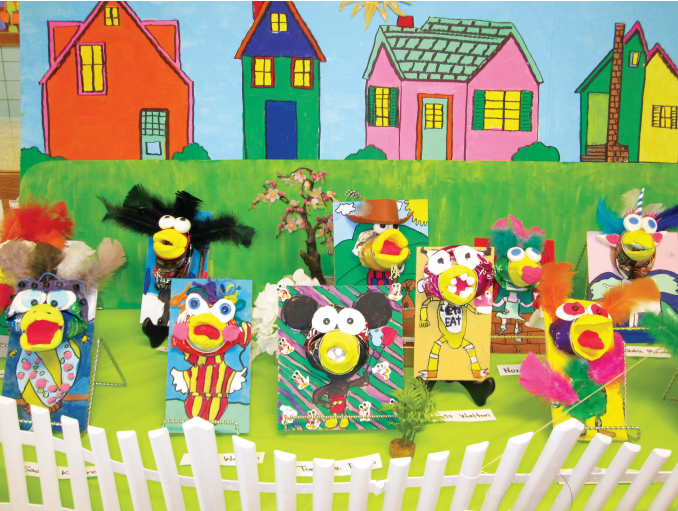 Trey Weston, grade five, used a colorful pattern
Trey Weston, grade five, used a colorful pattern
to make his bird clown.
I like for my students to experience working with clay at least once a year. Since we don’t have a kiln, I usually purchase several colors of a modeling compound.
I was searching for something new for my fifth-graders to make. I wanted something that could be large, but still only use a small amount of modeling compound (you can also use self-drying clay). I came up with this soda bird project. This new art form has been a hit with students because it allows them to create something different and utilizes modeling material (and soda cans) in a creative manner.
Inspired by John James Audubon
We began by studying John James Audubon and his exploration of North America as he searched for new bird species. He was an artist, historian, and scientist. Today, his artwork sells for millions. We also discussed his method of posing birds to study them for accuracy, and the 435 life-size paintings that took him fourteen years to complete. He is noted as being the most famous bird artist in the world. After our study of Audubon and his fascination with birds, students created their own bird relief sculptures.

A soda bird invasion in our school’s lobby
The Process
- Students traced a 2" (5 cm) circle on 5 x 7" (13 x 18 cm) chipboard to show where they would later glue their smashed soda can—the head of their bird. Next, they drew an imaginative bird body, outlined it in black permanent marker, and painted it in tempera.
- Students used modeling clay to shape a pointed or rounded upper and lower beak and attached it with white glue within the rim of the tab side of a smashed can. The beak was large enough to fill the circle. Breathing holes were made on the upper beak with a pencil.
- White clay was glued to the can for eye shapes. Beads or permanent markers were used to make pupils.
- The smashed soda can was hotglued onto the chipboard where they had traced the circle earlier.
- Extra clay was used for details such as eyebrows, cheeks, lips, and hair. Wires, feathers, buttons, doilies, and beads were also available.
Reusing and Repurposing
Students have had such fun with this assignment and it was easy on my budget. We’ve had Larry Birds, touCANS, penguins, pilots, and costumed birds as ballerinas, hula dancers, farmers, and so forth. Our annual display of birds is a welcome attraction to our school lobby. Students learn that they can reuse items in creative ways and create something worthwhile with minimal supplies.
Rita Roberts is an art teacher at Bradie Shrum Elementary School in Salem, Indiana. rroberts@salemschools.com
NATIONAL STANDARD
Creating: Conceiving and developing new artistic ideas and work.
WEB LINK
www.audubon.org/content/johnjames-audubon
View this article in the digital edition.


 Trey Weston, grade five, used a colorful pattern
Trey Weston, grade five, used a colorful pattern